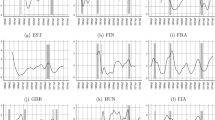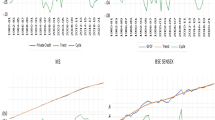Abstract
This paper explores the predictions of real business cycle theory on the roles of total factor productivity (TFP) and financial frictions to explain business cycles in emerging market economies (EMEs). I obtain evidence about TFP, price of capital, risk premium, and collateral constraint shocks by estimating structural vector autoregressions (SVARs) on a Brazilian sample from 1999Q1 to 2018Q4 and a Mexican sample from 1997Q1 to 2018Q4. On each sample, two SVARs are estimated. One SVAR identifies shocks by imposing restrictions on their short-run impact. The other SVAR is grounded on restrictions that shocks have long-run effects on business cycles in EMEs. Estimates of the SVARs show the TFP shock is the main driver of business cycle movements in Brazil and Mexico. However, this evidence is produced by the SVAR under the long-run restrictions, which indicates the identification of shocks matters to the explanation of business cycles in EMEs. Next, the Brazilian and Mexican business cycles are markedly different, as the contributions of shocks to aggregate fluctuations vary across the two countries. Hence, findings of this paper suggest although not all business cycles are alike in EMEs, “the cycle is the trend” view on aggregate fluctuations in EMEs remains valid. The empirical results of this paper are in support of the economic policies that aim to robustify the productivity process of EMEs.






Similar content being viewed by others
Notes
The working capital constraint forces firms to borrow internationally to pay for labor in order to produce. As a result, the working capital constraint creates a transmission mechanism in that shocks to international financial markets affect output in a SOE.
Bianchi and Mendoza (2018) are the representative paper for this macroprudential policy.
This paper had considered including other EMEs. However, there is a availability of data issue for other developing countries that forced them out of the empirical analysis. See Appendix for more details.
Longer Brazilian and Mexican samples are available. However, SVARs estimated on the longer samples produce badly behaved impulse response functions (IRFs) and FEVDs due to non-stationary endogenous variables. Discussions about the sample size are included in the Appendix.
See the Appendix for details about the sources and construction of data.
The small sample critical value for the Brazilian trade balance-output ratio equals \(-\)3.160 at the 10% significance level.
The potential of cointegration among the levels of variables is checked by applying the Johansen cointegration tests. The test results show that there are no cointegration among the I(1) variables in the Brazilian and Mexican samples. Refer to the Appendix for more details on cointegration.
The Appendix details the transformation from real GDP growth, the first difference of the log world real interest rate, the first difference of log Tobin’s Q, and the trade balance-output ratio to real GDP, the world interest rate, Tobin’s Q, and the trade balance.
The remaining IRFs are available in the Appendix.
In their SOE-RBC model, a positive TFP shock loosens the KM collateral constraint that enables a small open economy to borrow more foreign debt. As a result, the demand for capital increases its price.
I interpret point estimates of FEVDs greater than 20% as economically important and confidence bands surrounding the median estimate of a FEVD greater than 40% interval as large uncertainty.
Sensitivity checks using a different lag length, and a different ordering of variables are included in the Appendix. Results from sensitivity checks confirm the robustness of the empirical findings.
References
Aguiar M, Gopinath G (2006) Defaultable debt, interest rates and the current account. J Int Econ 69(1):64–83
Aguiar M, Gopinath G (2007) Emerging market business cycles: the cycle is the trend. J Polit Econ 115(1):69–102
Akinci, (2013) Global financial conditions, country spreads and macroeconomic fluctuations in emerging countries. J Int Econ 91(2):358–371
Arellano C (2008) Default risk and income fluctuations in emerging economies. Am Econ Rev 98(3):690–712
Benguria F, Matsumoto H, Saffie F (2022) Productivity and trade dynamics in sudden stops. J Int Econ 139:103631
Bhattarai S, Chatterjee A, Park WY (2021) Effects of US quantitative easing on emerging market economies. J Econ Dyn Control 122:104031
Bianchi J, Mendoza EG (2018) Optimal time-consistent macroprudential policy. J Polit Econ 126(2):588–634
Blanchard OJ, Quah D (1989) The dynamic effects of aggregate demand and supply disturbances. Am Econ Rev 79(4):655–673
Boz E, Daude C, Bora Durdu C (2011) Emerging market business cycles: learning about the trend. J Monet Econ 58(6):616–631
Bruno V, Shin HS (2015) Capital flows and the risk-taking channel of monetary policy. J Monet Econ 71:119–132
Calvo GA, Izquierdo A (2006) Sudden stops and phoenix miracles in emerging markets. Am Econ Rev 96(2):405–410
Dickey D, Pantula SG (1987) Determining the ordering of differencing in autoregressive processes. J Bus Econ Stat 5(4):455–61
Dieppe A, Francis N, Kindberg-Hanlon G (2021) Technological and non-technological drivers of productivity dynamics in developed and emerging market economies. J Econ Dyn Control 131:104216
Eaton J, Gersovitz M (1981) Debt with potential repudiation: theoretical and empirical analysis. Rev Econ Stud 48(2):289–309
García-Cicco J, Pancrazi R, Uribe M (2010) Real business cycles in emerging countries? Am Econ Rev 100(5):2510–2531
Hayashi F (1982) Tobin’s marginal q and average q: a neoclassical interpretation. Econometrica 50(1):213–24
Itskhoki O, Moll B (2019) Optimal development policies with financial frictions. Econometrica 87(1):139–173
Kim Y, Lim H, Sohn W (2020) Which external shock matters in small open economies? Global risk aversion vs. US economic policy uncertainty. Jpn World Econ 54:101011
Kiyotaki N, Moore J (1997) Credit cycles. J Polit Econ 105(2):211–248
Mendoza EG (2010) Sudden stops, financial crises, and leverage. Am Econ Rev 100(5):1941–1966
Neumeyer PA, Perri F (2005) Business cycles in emerging economies: the role of interest rates. J Monet Econ 52(2):345–380
Ng S, Perron P (1995) Unit root tests in ARMA Models with data-dependent methods for the selection of the truncation lag. J Am Stat Assoc 90(429):268–281
Olea JLM, Plagborg-Møller M (2019) Simultaneous confidence bands: theory, implementation, and an application to SVARs. J Appl Econ 34(1):1–17
Reyes-Heroles R, Tenorio G (2019) Regime-switching in emerging market business cycles: interest rate volatility and sudden stops. J Int Money Financ 93:81–100
Schmitt-Grohè S, Uribe M (2016) Adjustment to small, large, and sunspot shocks in open economies with stock collateral constraints. Working paper no. 22971 (December), NBER, Cambridge, MA
Tillmann P, Kim G-Y (2019) The spillover effects of U.S. monetary policy on emerging market economies. Int J Financ Econ 24(3):1313–1332
Uribe M, Yue VZ (2006) Country spreads and emerging countries: who drives whom?. J Int Econ 69(1):6–36
Acknowledgements
I am grateful and indebted to Jim Nason for his guidance and support. I extend my gratitude to two anonymous referees, Giuseppe Fiori, Daisoon Kim, and Xiaoyong Zheng, for their thoughtful comments and suggestions. I thank Givi Melkadze, Margaret Jacobson, and participants at the Business Fluctuations session at the 91st Southern Economics Association conference for helpful comments. My thanks also go to Tasha Bigelow for editorial assistance.
Author information
Authors and Affiliations
Corresponding author
Ethics declarations
My name is Bira Zhahadai. I am a assistant professor from the department of economics at Illinois Wesleyan University. This paper is original and has not been published elsewhere, nor is it currently under consideration for publication elsewhere. I have no conflicts of interest to disclose. Please address all correspondence concerning this paper to me at bzhahada@iwu.edu. All remaining errors are my own.
Additional information
Publisher's Note
Springer Nature remains neutral with regard to jurisdictional claims in published maps and institutional affiliations.
Supplementary Information
Below is the link to the electronic supplementary material.
Rights and permissions
Springer Nature or its licensor (e.g. a society or other partner) holds exclusive rights to this article under a publishing agreement with the author(s) or other rightsholder(s); author self-archiving of the accepted manuscript version of this article is solely governed by the terms of such publishing agreement and applicable law.
About this article
Cite this article
Zhahadai, B. Are business cycles in emerging market economies alike?. Int Econ Econ Policy 20, 537–561 (2023). https://doi.org/10.1007/s10368-023-00567-8
Accepted:
Published:
Issue Date:
DOI: https://doi.org/10.1007/s10368-023-00567-8




